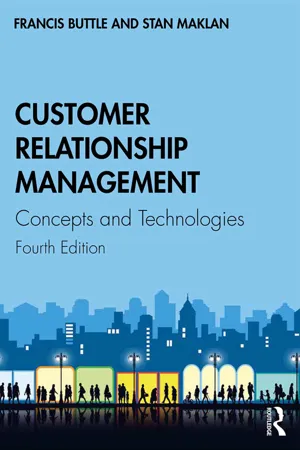
Customer Relationship Management
Concepts and Technologies
Francis Buttle,Stan Maklan
- 444 pages
- English
- ePUB (mobile friendly)
- Available on iOS & Android
Customer Relationship Management
Concepts and Technologies
Francis Buttle,Stan Maklan
About This Book
Customer Relationship Management, Fourth Edition continues to be the go-to CRM guide explaining with unrivalled clarity what CRM is, its uses, benefits and implementation. Buttle and Maklan take a managerial perspective to track the role of CRM throughout the customer journey stages of acquisition, retention and development. Theoretically sound and managerially relevant, the book is liberally illustrated with examples of technology applications that support marketing, sales and service teams as they interact with customers, but assumes no deep technical knowledge on the reader's part. The book is structured around three core types of CRM – strategic, operational and analytical – and throughout each chapter, case illustrations of CRM in practice and images of CRM software demystify the technicalities.
Ideal as a core textbook for advanced undergraduate and postgraduate students on CRM or related courses such as relationship marketing, digital marketing, customer experience management or key account management, the book is equally valuable to industry professionals, managers involved in CRM programs and those pursuing professional qualifications or accreditation in marketing, sales or service management.
NEW TO THIS EDITION:
- New and updated international case illustrations throughout
- New and updated screenshots from CRM applications
- Fully updated to reflect the evolving CRM landscape, including extended coverage of:
-
- Big data and its influence on CRM
- Artificial intelligence (AI)
- Advances in CRM analytics
- The relationships between CRM and customer experience management
- The role of social media in customer management strategy
- Real-time marketing
- Chatbots and innovative customer self-service
- Privacy and data security
- Updated lecturer support materials online
Frequently asked questions
Table of contents
- Cover
- Half Title
- Title
- Copyright
- Contents
- List of figures
- List of tables
- Preface
- Acknowledgements
- Section A Understanding customer relationships
- Section B Strategic CRM
- Section C Operational CRM
- Section D Analytical CRM
- Section E Realizing the benefits of CRM
- Section F Looking to the future
- Index